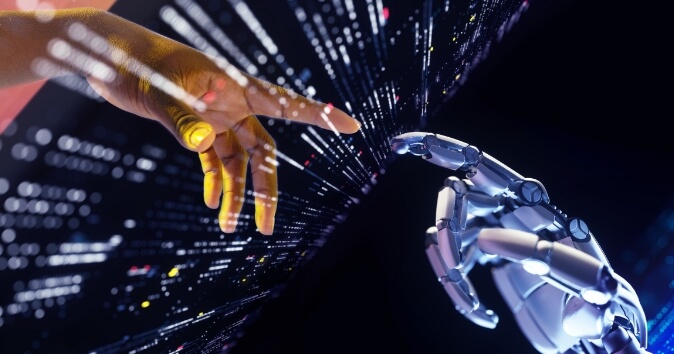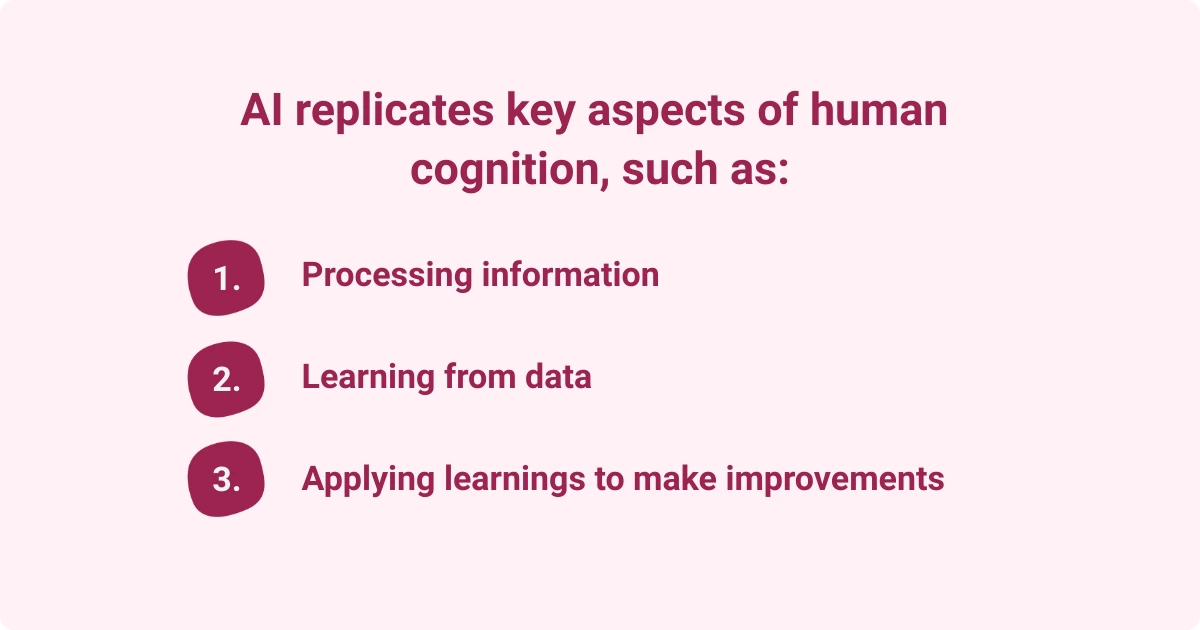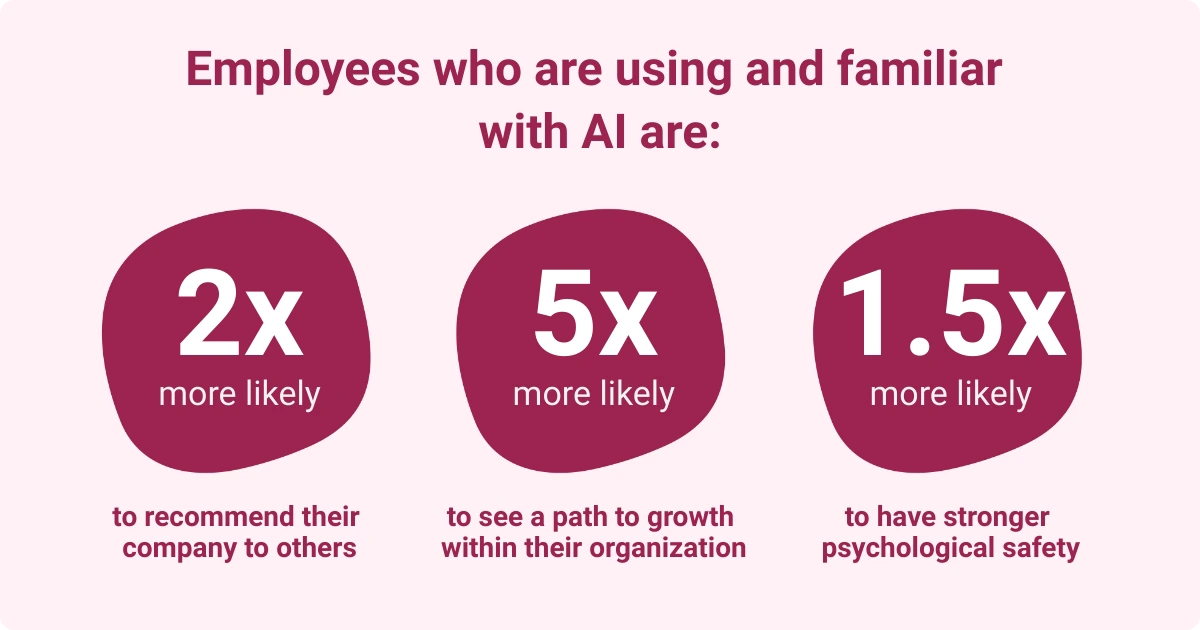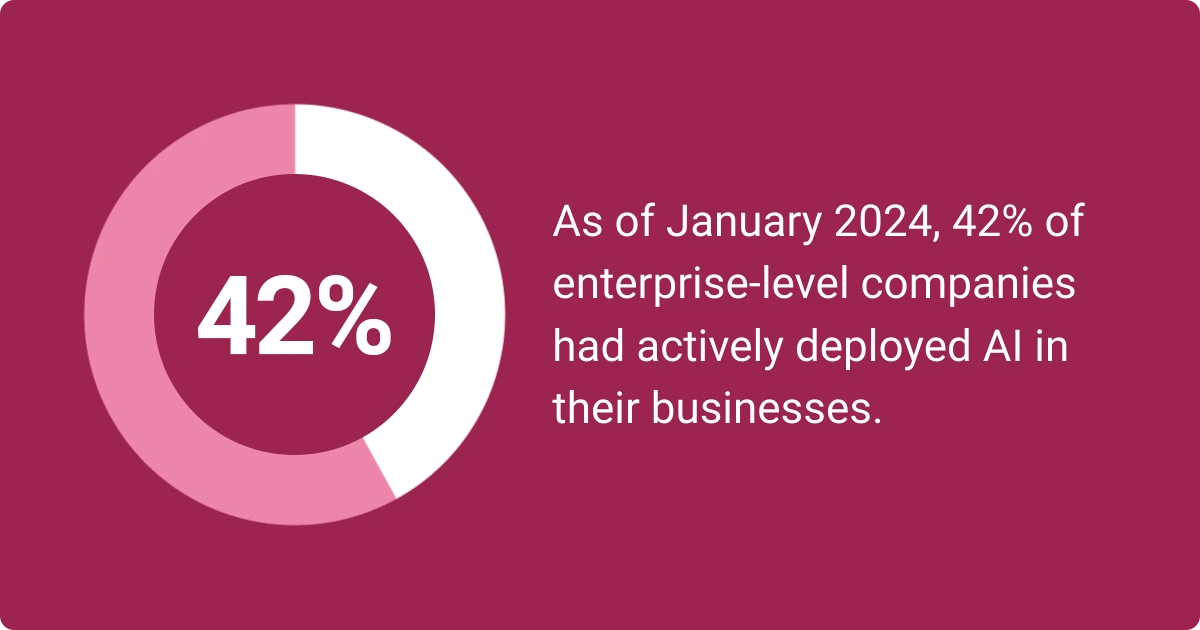Human-AI Collaboration: Shaping the Future of Intelligent Partnerships
Table of contents
- Introduction to human-AI collaboration
- Impact of human collaboration with AI systems
- Examples of human-AI collaboration
- Skills and competencies for effective collaboration with AI
- Frameworks for facilitating human and AI system collaboration
- Organizational strategies for integrating AI
- Challenges and ethical considerations
- Future trends in human-AI collaboration
- Conclusion and implications

A recent Workhuman® survey found that 42% of respondents use generative artificial intelligence in their employee workflows at least weekly. This highlights the growing importance of AI in the workplace and hints at a future where "coworker" may no longer refer exclusively to human colleagues.
For companies, AI is an opportunity to enhance efficiency and productivity. However, it also poses challenges, such as reskilling employees and encouraging teams to embrace AI as a tool for improving, not replacing human work.
Explore the outcomes of human-AI collaboration, from understanding human and artificial intelligence as complementary rather than contentious to strategies for integrating AI into the workplace.
Introduction to human-AI collaboration
Artificial intelligence is reshaping workplaces in nearly every industry, from AI-powered chatbots that enable businesses to offer 24/7 customer service and support to AI algorithms that help doctors detect, diagnose, and treat patients. Yet the wave of tech breakthroughs enabling the use of AI in the workplace has been met with apprehension as well as enthusiasm.
While innovations like AI automation relieve workers who struggle to balance necessary yet repetitive tasks with their more strategic and creative functions, many worry that AI outsourcing is the beginning of the end of human predominance in the workplace.
Fortunately, the most recent research on AI technologies suggests that fears that AI will fully replace human intelligence at work are misplaced. Rather than a labor landscape where computers fill roles once occupied by humans, the future of work is likely to be characterized by collaborative ventures that harness AI power to make human work more, not less, valuable.
What is human-AI collaboration?
Human-AI collaboration refers to strategic partnerships between humans and artificial intelligence to accomplish shared organizational goals. By combining human skills and expertise with AI functionality, these partnerships capitalize on the unique strengths of both to improve business outcomes.
Its computational power gives AI certain capabilities that human intelligence cannot match. Research from the 58th Hawaii International Conference on System Sciences on how human-AI collaboration transforms organizational innovation practicesOpens in a new tab shows that AI is very good at mimicking certain aspects of human cognition.
For example, AI can process information, learn from it, and apply learning to make improvements—and it can do so with greater speed and accuracy than the human brain.

AI also outshines human intelligence in areas that require advanced computational abilities, such as:
- Predictive analytics
- Pattern recognition
- Data simulation
However, AI fails to match human capabilities in areas like critical thinking, social intelligence, and creativity.
Human-AI collaboration marries AI capabilities with complementary human strengths to optimize operations, improve productivity, and fuel innovation. With AI performing tasks like data analysis and insight extraction, humans can refocus their energies on the areas requiring soft skills that AI lacks.
At Workhuman, we call this marriage of human-centric data and AI Human Intelligence™.
Our team of data scientists developed and trained AI models on vast amounts of rich recognition data to elevate previously hidden insights into recognized behaviors, team dynamics, and emerging leaders. However, it's the human element—the contextual understanding of authentic recognition and your emotional intelligence and strategic thinking—that turns insights into outcomes.
Combining AI's ability to process this dynamic data with human leaders' ability to contextualize and act on it, organizations can foster a more responsive, agile, and people-centric workplace.
With highlights from the AI AssistantOpens in a new tab and Workhuman iQ snapshots, HR and people leaders get an up-to-date pulse on employee morale, cultural alignment, and performance through recognition patterns and trends that enable you to proactively address issues, celebrate success, and adapt strategies as they arise.
As your organization changes and your program evolves, so do your insights. The continuous flow of recognition creates a sustainable source of real-time insights that help you make data-driven decisions, foster a culture of appreciation, and align recognition strategies with organizational goals
Together, AI's analytical capabilities and human expertise create a synergistic partnership that can enhance employee engagement, retention, and overall organizational success.
It's important to understand these are not siloed efforts. Collaboration is the key word. Effective collaboration between human workers and AI tools is an ongoing process calling for dynamic practices to leverage the relative strengths of both sides to meet organizational goals.
Understanding your employees' strengths and weaknesses through skills evaluations is an important factor in fostering successful collaborations between your team and AI.
Impact of human collaboration with AI systems
Research from "Effective human–AI work design for collaborative decision-making," published in the cybernetics journal Kybernetes, found that the synergistic relationship between human capability and AI functionality can optimize efficiency in even the most complicated organizational environments.
Augmentation of human workflows by collaborative AI systems can streamline processes, reduce errors and inconsistencies, and boost workplace productivity across industries. Some of the key integrations that lead to increased operational efficiency include:
- Task automation: A range of standard organizational tasks can be reassigned to AI, which can often perform them more quickly and with fewer mistakes than humans. Examples include administrative duties like scheduling and email management, project planning and management, and data analysis.
- Employee assistance: AI assistance can positively impact worker productivity across industries. According to the Bipartisan Policy Center blog on AI and worker productivityOpens in a new tab, diverse professionals, including coders, customer service representatives, public relations representatives, and taxi drivers, performed their job functions more quickly with the help of AI tools.
- Communication optimization: From AI content generation to chatbots, translators, and programs that analyze and respond to user inputs, human-AI collaboration can improve how employees communicate and streamline how organizations handle external communications.
For example, AI tools like Google Dialogflow integrate conversational interfaces into customer-facing products like websites and mobile apps.

Examples of human-AI collaboration
The real-world applications of human-AI collaboration are expansive and changing rapidly. Let's take a look at human-machine collaboration examples across industries, from professional creatives who use AI tools to enhance output to doctors, supply chain analysts, and educators.
In education
Human-AI collaboration can make learning better for humans and teachers alike. Key applications include:
- Learning personalization: AI's analytic capabilities can be applied to data about student performance and individual learning styles to generate custom educational content that personalizes learning experiences.
- Intelligent tutoring: AI-enhanced tutoring systems are educational software programs that use AI to track student work, provide personalized instruction, and tailor feedback to improve student performance.
- Educator assistance: Educators can use AI tools that automate the administrative aspects of teaching, including grading, scheduling, and lesson planning.
In healthcare
AI tools are transforming nearly every corner of the healthcare industry, from diagnosing illnesses to developing new medications. Those transformations are about more than improving efficiency in hospitals and doctor's offices.
AI is also improving patient care and the treatment of illnesses in a variety of areas:
- Patient diagnostics: Healthcare professionals can merge their expertise with AI's analytic capabilities to improve patient diagnosis. For example, doctors can use AI to review MRI results, X-rays, and CT scans, enabling them to detect illnesses more quickly and accurately.
- Disease tracking: AI can help healthcare professionals optimize methods for predicting, preventing, and tracking infectious disease outbreaks on local, national, and international scales.
- Surgeries: Robotic systems that run on AI can assist in performing surgeries requiring extreme precision. These systems have successfully performed heart procedures, colonoscopies, cochlear implants, and more.
In business and finance
In the business and finance sector, human-AI collaboration is a powerful tool for reducing common human errors in process and analyzing data. Professionals in these industries can also leverage AI tools to streamline procedures for document processing, onboarding new employees, and managing client relationships.
In manufacturing and logistics
One of the most significant benefits AI offers manufacturing and logistics companies is its mastery of predictive analytics, which enables businesses to optimize a range of their most important tasks, such as:
- Demand forecasting
- Inventory and supply tracking
- Warehouse management
- Route optimization
- Supply chain management
In creative industries
The applications of human-AI collaboration in creative fields are widespread. As in other industries, creators can outsource mundane tasks to AI automation while they focus their energies on the creative work:
- Music composition: Through AI collaborations, musicians can explore new styles, experiment with melodies and harmonies, and analyze the attributes of past compositions.
- Visual art and design: AI can enhance creative visual output in several ways, including generating color palettes, iterating on designs, and revising existing images according to user instructions.
- Film and video: AI accomplishes time-consuming aspects of filmmaking much more quickly, including film editing, creating special effects, and optimizing on-set workflows.

Skills and competencies for effective collaboration with AI
Human employees may need training to develop basic AI literacy to optimize AI collaboration. Effective use of these tools requires a baseline understanding of AI's foundational concepts, such as:
- Machine learning: the AI field and technology that enables AI systems to emulate human learning
- Deep learning: AI systems that use multilayered neural networks inspired by the human brain
- Natural Language Processing (NLP): using machine learning to teach computers to read and process human language
- Computer vision: AI technology that enables computers to process visual information
Depending on organizational goals and the scope of integration, employees may need additional competencies, like data literacy, computer proficiency, and critical thinking.
Frameworks for facilitating human and AI system collaboration
What efforts can company leaders make to foster human-AI collaboration in the workplace? Let's explore a few strategies.
Coactive design framework
Coactive design involves the interdependencies between humans and machines in collaborative endeavors. The principles of coactive design can help conceptualize and encourage interactions between human and non-human entities, such as AI, in ways that put mutual aims and collaboration over individual skills.
Reciprocal human-machine learning models
Reciprocal human-machine learning models are interactive systems in which humans and machines learn from each other simultaneously. The machine learns by analyzing feedback on its performance from the human participant, while the human learns from insights generated by the machine. This effectively creates a learning loop where knowledge flows continuously between both sides.
Organizational strategies for integrating AI
As with any new technology, leaders should expect to encounter skill gaps in the workplace that could complicate AI integration. By taking proactive steps to address issues and identify areas of development, you can successfully manage these challenges.
Training programs focused on understanding and collaborating with AI tools are necessary for successfully introducing AI to teams. In addition to providing instruction on using AI tools, this training should educate team members about organizational goals for using AI and their own roles and responsibilities, all of which should be clearly established.
Additionally, leaders should understand that as exciting as AI integration is, many people are also wary of the changes it brings. It's important to thoughtfully engage your employees' questions and concerns, whether those stem from anxieties about AI replacing human workers or their ability to adapt their skill sets to AI tools.
Open dialogue, a comprehensive growth and development plan, and, above all, compassion and understanding are your greatest assets here.
Challenges and ethical considerations
Artificial intelligence presents unique ethical challenges as the technology enters the workplace
Ensuring security, transparency and explainability
Workplace uses of AI often involve entrusting AI systems with sensitive consumer, employee, and company data, making them appealing targets for cybercriminals. To protect all parties and, in some cases, comply with laws and regulations, companies may be challenged to develop and update their cybersecurity procedures.
Organizations must also protect the privacy of employees and other data subjects. This requires establishing transparent organizational data usage policies. Clearly communicating these policies to team members and keeping practices aligned with evolving standards and industry guidance helps build trust and accountability in the system.
Mitigating bias and ensuring fairness
AI systems learn from data, which does not guarantee impartiality. Unfortunately, biased data can influence outcomes. When AI outputs perpetuate systemic prejudice and discrimination, it's known as algorithmic bias.
Organizations risk legal trouble when implementing AI outcomes, which results in discrimination, so accounting for and addressing algorithmic biases is a top ethical concern when collaborating with AI. Discrimination may be a particular concern in hiring and recruitment practices, employee management, and performance assessment.
Future trends in human-AI collaboration
Current and future advancements in AI are set to optimize collaborations between humans and machines and enhance outcomes. For example, advancements in NLP continue to improve AI's ability to use and understand human languages, making collaborative interactions more natural.
Developments in Explainable AI make the logic behind AI results more comprehensible to humans, better equipping us to determine the trustworthiness of AI outputs.
Conclusion and implications
Human-AI collaboration is essential for fostering productive, competitive workplaces in the modern business landscape. By leveraging the complementary powers of human and machine intelligence, companies can streamline operations, reduce errors, and achieve business goals.
Creating a workplace where human and AI employees can collaborate effectively requires planning, flexibility, and education. While you will almost certainly encounter challenges, the long-term benefits will be transformative.